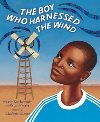|
The Boy Who Harnessed the Wind: Young Readers Edition

Last updated Wednesday, June 5, 2013
Author: William Kamkwamba
Date of Publication: 2012
ISBN: 0803735111
Grade Level: 3rd (GLCs: Click here for grade level guidelines.)
Date(s) Used: Jun. 2013
Synopsis:
When fourteen-year-old William Kamkwamba's Malawi village was hit by a drought, everyone's crops began to fail. Without enough money for food, let alone school, William spent his days in the library . . . and figured out how to bring electricity to his village. Persevering against the odds, William built a functioning windmill out of junkyard scraps, and thus became the local hero who harnessed the wind.
| Note to readers: |
| • |
If you choose to make pinwheels for the craft, please remember to use caution when making holes for the kids. Use a pencil, pointed scissors or use a hole punch if available, then the paper will spin over the brad more easily.
|
| Discussion topics for before reading: |
| • |
Have you ever seen a windmill?
|
| • |
What are windmills used for?
Vocabulary:
|
| • |
harnessed - to control something, usually in order to use its power: There is a great deal of interest in harnessing wind and waves as new sources of power.
|
| • |
pangas - a broad heavy knife of E Africa, used as a tool or weapon [from a native E African word]
|
| • |
maize - corn
|
| Discussion topics for during/after reading: |
| • |
What would the windmill bring to William's village?
|
| • |
What was needed to help the crops in William's village?
|
| • |
How did William learn to build things?
|
| • |
Where did William study Science and English?
|
*Note: These craft ideas are just suggestions.
You can use them, but you don't have to use them.
You can expand upon them, or add your own twist.
Remember, though, that the focus of your time should
not be on the development and execution of a craft;
the focus should be on the read-aloud and the
enjoyment of the book!
|
